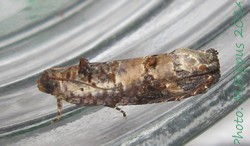
Adoxophyes is a genus of moths of the tribe Archipini.

Cryptophlebia ombrodelta, the litchi fruit moth or macadamia nut borer, is a moth of the family Tortricidae. The species was first described by Oswald Bertram Lower in 1898. It is native to India, Sri Lanka, Nepal, Indonesia, China, Taiwan, Vietnam, Thailand, western Malaysia, New Guinea, the Philippines, Japan, Guam, the Caroline Islands, Australia and has been introduced to Hawaii.

Dudua aprobola, the mango flower webworm or litchi leaf roller, is a moth of the family Tortricidae. The species was first described by Edward Meyrick in 1886. It is a pest on several economically important crops.

Isodemis serpentinana is a moth of the family Tortricidae first described by Francis Walker in 1863. It is known from China, India, Indonesia, New Guinea, the Philippines, Sri Lanka and Thailand.

Adoxophyes fasciculana, the bell moth or orange tip moth, is a moth of the family Tortricidae. It was described by Francis Walker in 1866 from the Moluccas. It is also known from South Asia, Vietnam, Australia and the Pacific Islands. It is a polyphagous pest on several commercially important crops.
Lobesia lithogonia is a moth of the family Tortricidae first described by Alexey Diakonoff in 1954. It is found in Thailand, Sri Lanka, Java, Borneo and New Guinea.

Homona coffearia, the tea tortrix or camellia tortrix, is a moth of the family Tortricidae. The species was first described by Nietner in 1861. It is widely distributed in the Oriental region.
Phricanthes flexilineana is a species of moth of the family Tortricidae first described by Francis Walker in 1863. The species was described from Sri Lanka, northern Queensland in Australia and the Seychelles, but has a much wider range, which includes Madagascar, India, Indonesia, Myanmar, New Guinea, the Philippines and Taiwan. It is also widely distributed in the tropical parts of North and South America.
Archips mimicus is a species of moth of the family Tortricidae first described by Lord Walsingham in 1900. It is found in India, Sri Lanka and Malaysia. In the Catalogue of Life, the species is considered as a synonym of Archips dispilana.
Strepsicrates rhothia is a species of moth of the family Tortricidae first described by Edward Meyrick in 1910. It is found in Taiwan, Sri Lanka, India, the Democratic Republic of the Congo, Ghana, Madagascar, Mauritius and South Africa.
Meridemis invalidana is a species of moth of the family Tortricidae first described by Francis Walker in 1863. It is found in India, Sri Lanka, Nepal, Vietnam, Malaysia, China, Taiwan and Korea.
Meridemis detractana is a species of moth of the family Tortricidae first described by Francis Walker in 1863. It is found in Sri Lanka.
Neocalyptis affinisana is a species of moth of the family Tortricidae first described by Francis Walker in 1863. It is found in India, Sri Lanka, Vietnam, Indonesia, Taiwan and Japan.
Acleris extensana is a species of moth of the family Tortricidae first described by Francis Walker in 1863. It is found in Sri Lanka, India, China and Vietnam.
Brachiolia egenella is a species of moth of the family Tortricidae first described by Francis Walker in 1864. It is found in Sri Lanka, India, South Africa and on the Comoros and Mauritius.

Cnesteboda celligera is a species of moth of the family Tortricidae first described by Edward Meyrick in 1918. It is found in India, Sri Lanka, Vietnam, Taiwan, Malaysia and Indonesia.
Herpystis jejuna is a moth of the family Tortricidae first described by Edward Meyrick in 1916. It is found in India, Sri Lanka, and Fiji.
Metrioglypha confertana is a moth of the family Tortricidae first described by Francis Walker in 1864. It is found in India, Sri Lanka and New Guinea.
Didrimys harmonica is a moth of the family Tortricidae first described by Edward Meyrick in 1905. It is found in Sri Lanka, Java, Borneo and New Guinea.






